Ron Ludekens
L.E. Cooke Co Bare Root Nursery Division Closure
Ghost Hill™ White Texas Everbearing Fig
Rhubarb Recipes
Enjoy.
Ron Ludekens 1-7-2016
Persimmon Yellow Leaf Color - Spring
QUESTION: In fall of 2014 I planted my 3/4" stock Jiro Persimmon into the ground. This spring it leafed out nicely, however, the leaf color is yellowish, rather than a deep healthy green. Any suggestions on fertilizing? Also, what kind of watering schedule is best for my tree. I bought it from Evergreen Nursery in San Leandro. Thanks,
Lillian
ANSWER:

Normal Spring New Foliage on Fuyu (Jiro) Persimmon
Lillian,
Thank you for your question and thank you for supporting one of our fine retail nurseries. One of the reasons I like persimmons so much (besides the wonderful fruit) are the extra features they bring to the yard. Some of them, exhibit an attractive spring foliage such as your Fuyu (Jiro). Others have a pronounced orange fall color. All have a clean, generally pest free appearance all summer long. The yellow spring foliage on the Fuyu (Jiro) is normal. These are photos of some of the trees in our orchard showing the colorful new spring foliage:

So to answer your questions and ease your fears, yellow is normal in the spring - enjoy it. It should turn darker green in a few weeks.

Fuyu (Jiro) Spring Foliage
The California Rare Fruit Growers (CRFG.org) has this page that helps answer your other questions on fertilizing (I would wait a nother month or two first) and watering: Persimmon Care - CFRG.org
More photos of all the other persimmons we grow and any special spring or fall colors can be found here: Persimmon Photos
Ron Ludekens 5-8-2015
Grapevine Fall Color

Blueberry Grape Fall Color
Too many years ago I was in the Napa wine country during Thanksgiving weekend. The fall colors were stunning. I only had my point and shoot camera then and have always wanted to go back during peak color with my good cameras and lenses. But alas, I have been thwarted with other duties and will hope again for "next year".
Today I made a quick trip to the budwood orchard to get some Hachiya Persimmons so my wife can bake persimmon cookies this weekend. The next row over we have a single row (row 26) with a lot of single vines of most of our grapes. There were a number with some really nice red leaves still hanging on the vines. So I stopped and took a couple of shots.
This visit reminded me that many grapevines have a spectacular fall color season. And if you look close in the spring at the new growth you will also see pink and red new foliage. A lot of the purple and red grapes (both seedless, table and wine grapes) show their colors in the leaves of autumn.
One of our most recent introductions which we are really impressed with is the Blueberry Grape. So I was thrilled to capture some of its fall color in the photo above. Put another star on this wonderful selection!
Here are two more from this afternoon's visit:

Summer Royal Grape Fall Color

Black Emerald Grape Fall Color
An arbor draped in red. A fence covered in magenta. Not a bad way to end the harvest season.
Ron Ludekens 12-5-2014
The Challenges and Effects of Record Drought
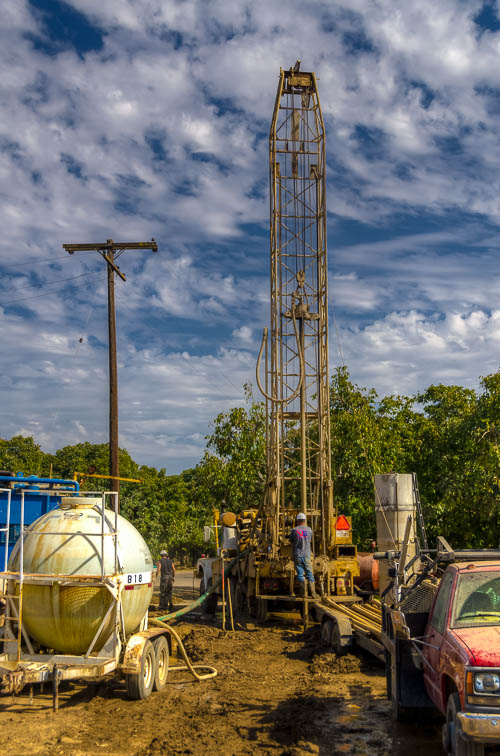
Drilling first of the new wells
It rained yesterday! That is a big event considering the last three years of drought. In fact we have had half as much rain in the last two weeks as we had all of last year. But 1 1/2 inches of rainfall is not much. Three years of drought with last year breaking all the records at only a little over 3 inches for the whole year.
In spite of advance planning and extra preparation in anticipation of water woes this growing season, we still experienced drought effects on this year's crop. The crop looks good but, for the most part, caliper sizes are smaller by one to two grades. Except for the desert loving trees and shrubs which actually got larger than normal.
We learned some lessons this year. Drip systems are marvelous, but not the total answer to extreme dry conditions. Until this last year, there has always been residual moisture below the surface of the soil from winter rains. This has givin us adequate moisture in the soil profile to plant with in the spring and supplement the drip systems through the year. Although our trees thrive on the drip systems we use, it is now obvious that they also must have used more water and nutrients from further away in the soil profile which were not there this year. Lesson learned: pre-irrigate in the early spring if we do not get winter rains again.
Drip systems are also not as forgiving when water is not applied exactly when needed. When we used to flood irrigate, we would irrigate every 10-14 days with lots of water residing in the soil profile below the surface. With drip, there is only the small amount in the immediate root zone. We water on drip every couple of days. With none extra in the soil profile, the tree will stress and shut down if water is not available in a timely fashion. There were several hiccups this summer in spite of our pre-planning for the drought.
Last spring, in anticipation of water woes (wells running dry), we connected multiple wells across common blocks of fields with surface piping. Some newer wells are deeper than the older wells. As feared, the water table dropped another 15-25 feet and, in the course of the summer, 8 older wells temporarily ran out of water until we could get the bowls lowered. While in this process, we still fed the drip from other wells while we lowered the bowls. Unfortunately a few were lowered to near the bottom of the hole.
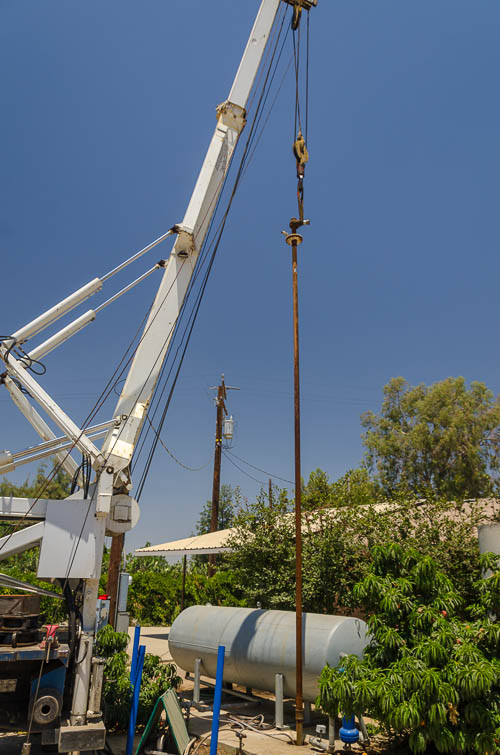
June 12, 2014 - First well to burp air was our office domestic water supply. Adding lengths of pipe to lower it. Replaced moter to accomodate greater depth. Since it is right outside my office window, I took plenty of photos of this well over the summer.
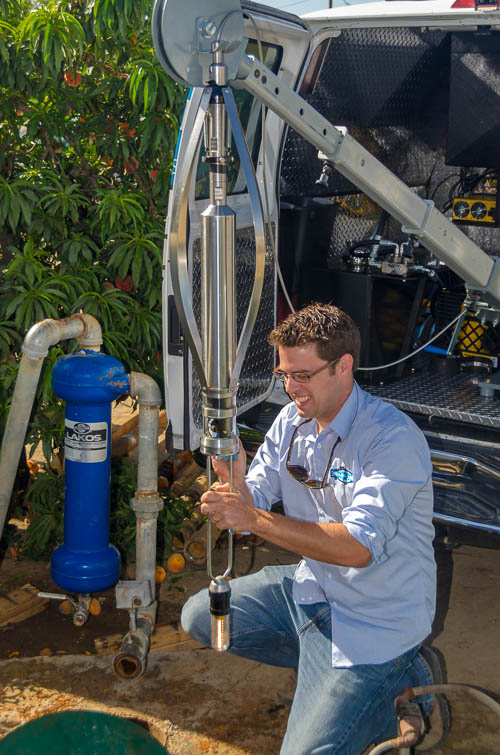
June 13, 2014. Inspecting the well casing. Water came up dirty from the lowered pump. High tech to the rescue. Lowered this camera down the well to see what was happening. Unfortunately (not for him), we ended up using this service several more times over the summer with other wells.
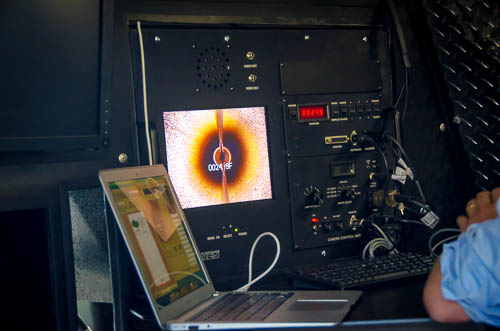
Inside the van is a computer console that shows what the camera sees, records it all to DVD and prints snapshots of any concerns seen.
When a pump draws water from the bottom of the well, it also pumps sand. Although we have filters (had to clean some of them every 20 minutes), sand still gets into the drip. As you know, drip systems don't like sand. We had to abandon the drip on 2 fields and quickly convert it back to furrow irrigation. With drip running on a healthy well, we can water 100+ acres all at one time from one well. Furrow irrigation can water about 15 acres at a time which takes many more days (and nights) to traverse a field. On these two fields, because of the added time to get the first furrow irrigation across to all the trees, we lost some of the water loving trees. Some of the other trees in the field had a midsummer shutdown (and slow restart) making for smaller sizes. For example, Babylonica Willow clearly is not drought tolerant and the reduced quantities available reflect that fact. On the other hand, the Chilopsis (Desert Willow) and Cercis occidentalis (Western Redbud) loved it.
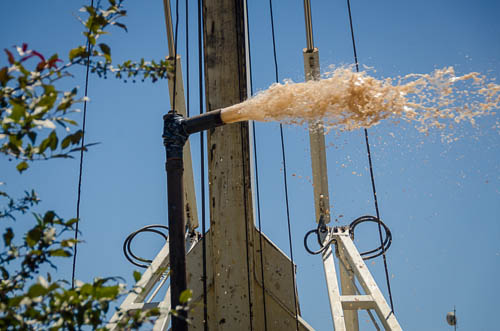
June 13, 2014 Blowing sandy water from domestic well. Tried this to see if we could clean out the base of the well.
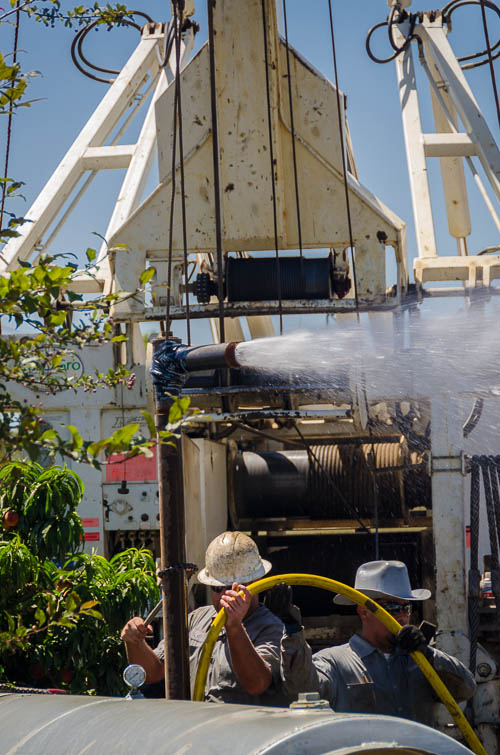
High pressure air is pumped into the well to blow out the sand (water is already clearer here).
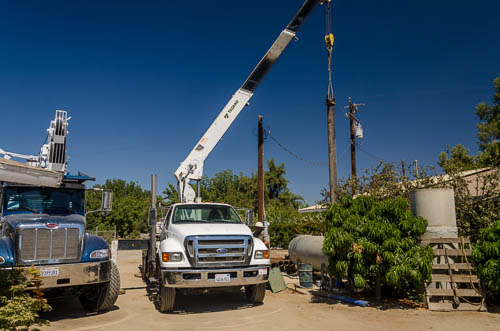
August 28, 2014 - Well is deep enought, just too much sand and dirty water going into filters from rusted holes in steel casing. Decided to re-sleeve the office domestic well to solve that. Over the course of the summer, this submersible pump was pulled 4 times (last time was to replace defective new motor under warranty).
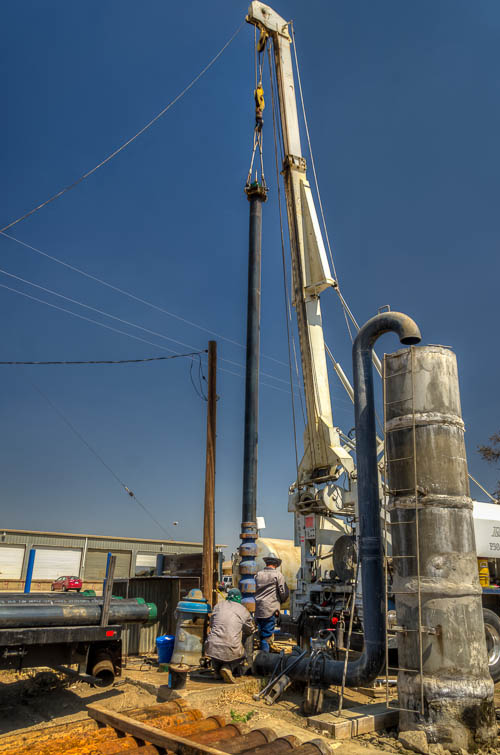
Lowering the pump bowls on Cooke 3B Ag well.
This summer and fall we have been drilling new wells (the waiting list is long and the cost is steep - supply and demand at work). On each major block of land we have drilled one well extra big and extra deep. And the water systems on these fields are all tied together. With these new wells and the work done on the existing wells, we are insuring the future of our water supply for years to come even if the drought continues. I hope politics doesn't change the game. By the time all the bills come in, we will have spent well over a half million dollars to keep the water flowing this summer and for the future. Welcome to farming!

Photo at very top of blog is from October 20, 2014 where we drilled a much deeper and larger well to handle water needs (if necessary) for all 6 fields in Cooke 3 (A,B,C,D,E,F). This perferated 23" PVC casing was put down all the new holes. Although more expensive than steel, it will not rust which prevents future problems.
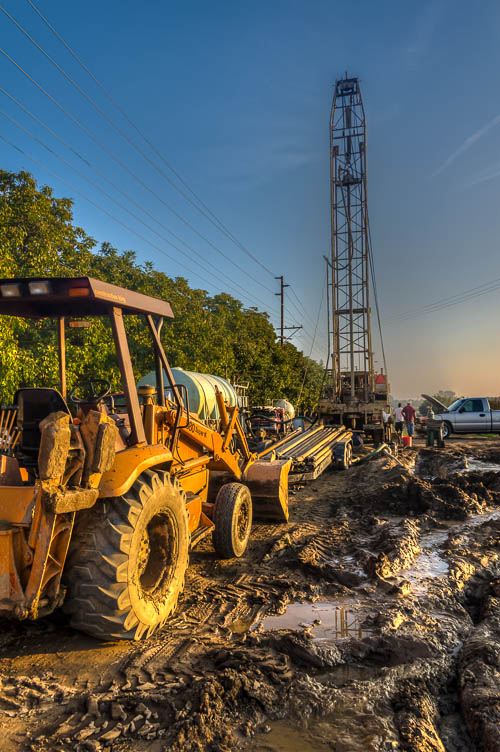
Evening of November 6, 2014 - Drilling large well for Cooke 5 block (Fields A,B,C,D) with ties to Cooke 2 (A,,B,C,D), Duarte and Mello fields. These drillers have been working around the clock due to wide spread water problems in this vast agricultural area. Trust me, they are all able to buy new vehicles. By morning they reached 400 feet with 23' bit.
I am proud of the extra efforts our production and maintenance staff put in this summer to reduce the effects of weather conditions beyond our control. It was an expensive and not so fun summer for all of us but we got the job done and learned a few new lessons along the way. Over the winter we plan to work on lowering and inspecting a few more wells before they need to go back into service. We are committed to serving you with quality trees now and into the future.
In the meantime, keep praying for rain!
Ron Ludekens 12-3-2014
Chocolate Persimmon vs Black Sapote

Chocolate Persimmon (Diospyros kaki)
Question: I had a question about the chocolate persimmon. Is this the same tree as a black sapote? The latin name for the chocolate persimmon on the tag I bought from green thumb from lecooke.com is Diospyros kaki. However, the latin name for the black sapote seems to be Diospyros digyna. When I look on the Internet some sites say that the chocolate persimmon and the black sapote are the same. So, when I bought your chocolate persimmon from the green thumb was I buying a black sapote? Can you please clear this up for me? Thank you. Alan, Long Beach, CA
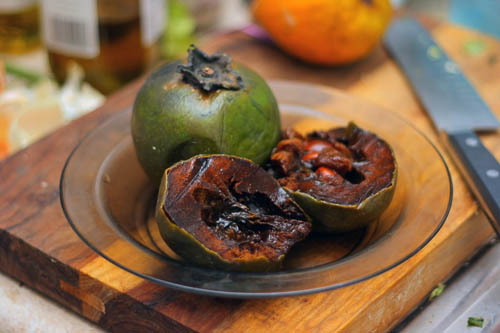
Ripe Black Sapote (Wikipedia - Creative Commons image by Alesh Houdek)
Answer: No. Black Sapote is not the same as our Chocolate Persimmon. According to Wikipedia: "Black Sapote (Diospyros nigra or Diospyros digyna)... Sapote are tomato-like and measure 5–10 cm (2.0–3.9 in) in diameter, with an inedible skin that turns from olive to a deep yellow-green when ripe and a pulp which is white and inedible when unripe but assumes a flavor, color and texture often likened to "Chocolate pudding" when ripe.
Notice the description difference. Black Sapote, when ripe, has a olive to deep yellow-green skin. The Asian Chocolate Persimmon has a boldly orange skin. The Black Sapote has a tomato shape. The Asian Chocolate Persimmon is elongated, much like a smaller sized Hachiya Persimmon. I cannot speak about the taste since I have not eaten a Black Sapote.
There is some commonality. The Asian Chocolate Persimmon must be eaten ripe or at least when the flesh turns chocolaty color. When ripe, the internal seed splits and releases compounds that changes not only the color of the flesh, but also changes it from astringent to non-astringent. If you find one that is seedless, then it will be astringent until ripe - "pudding soft".
Ron Ludekens 9-4-2014
More information on our Chocolate Persimmon: Information Page
More Chocolate Persimmon photos: Photos
Velvet Touch™ Russian Olive
What is Wrong with This Picture?

Tom Hugging Velvet Touch™ Russian Olive
Eleagnus angustifolia (Russian Olive) has two monstrous strikes against it. 1) It is naturally, dangerously throny. The 2-3 inch daggers at each leaf node slices and dices skin very nicely. Makes for a very good barrier if you don't like your neighbors cutting through your property . 2) It is rapidly showing up on many invasive species lists across the country. Rightly so - it will grow nearly anywhere and self propagates from seed and we stopped growing and selling it.
. 2) It is rapidly showing up on many invasive species lists across the country. Rightly so - it will grow nearly anywhere and self propagates from seed and we stopped growing and selling it.

Seedling Russian Olive - nearly every leaflet is a thorn. By our field workers, it is the most despised tree we have grown.
So why would Tom be hugging one? Because this is the Velvet Touch™ Russian Olive introduced by the L.E. Cooke Co a number of years ago and it is vastly different for all the right reasons.
1) It is not thornless, but nearly so. The few thorns are short and generally much softer.

Velvet Touch™. See any thorns?

Full disclosure: If you look, you can see a few thorns on Velvet Touch™ so cannot claim it is thornless.
2) Planted by itself, we have seen little to no seed. Planted right beside other Eleagnus angustifolia trees that generate copious viable seed, we find very little seed and they appear to be "blanks". A lot more watching needs to happen before we can confidently say this variety is sterile, but we are confident that it falls far below the threshold for being an invasive problem.
3) The silvery green leaves are 2-3 times the size of the noramal Russian Olive and has a soft velvety texture. It stands out as an ornamentally attractive tree in our scion wood orchards (see last photo at bottom).

Seedling Russian Olive on left - Velvet Touch™ on right
More Comparison Photos: Velvet Touch™ vs Seedling
4) The bark sheds providing attractive charater.

Attractive bark of Velvet Touch™ Russian Olive
5) It will grow nearly anywhere. Good from the hot deserts (drought tolerant) to USDA Zone 2. We have shipped a lot of these into Canada.

A very good looking tree
Bottom line - the Velvet Touch™ Russian Olive needs to be planted and enjoyed.
Ron Ludekens 8-28-2014
Point of Sale Page: Velvet Touch™ POS Page
Gallery of Photos of both Velvet Touch™ and the regular seedling for comparison: Eleagnus angustifolia Photo Galleries
Pineapple Pear

Large Size of Pineapple Pear (my hand is not small)
Doesn't that look yummy? Took the photo this morning. Give it a couple of days to finish ripening off the tree and I will be delightfully devouring it. It has a hint of pineapple flavor to its flesh, hence its name. What is exciting, this pear can be grown in the yards of the majority of homes in the U.S.
Pineapple Pear only requires about 200 hours of winter, dormant chilling which means it can grow all the way down to San Diego and Gulf Coast. Yet, as a pear, it can withstand cold to USDA Zone 6. It will bloom a little bit earlier, so late frosts can impact crops on some years in some areas (you know who you are). It ripens in August in Central California so short season climates can still get a crop.

The other exciting thing about this pear is its apparent resistance to Fireblight. On a scale of 1 to 9 with 9 being the best, we have graded this pear as an 8. In our climate, we just do not see Fireblight as an issue. (Disclaimer: I am convinced that there are different strains of Fireblight across the country with varying results, but so far feedback has been good).

Very Young Pineapple Pear Tree - Heavy with Fruit
(Planted on 1-14-13, photo taken today on 8-26-14)
Another feature that makes homeowners very happy is how early it will fruit once planted. They often fruit first year. The above photo shows one of five pear trees planted 19 months ago and all are setting heavy fruit for the poor small trees (note the broken branch). I would prefer the fruit be removed or thinned on young trees to allow more rapid vegetative growth, but we also want to verify every tree we plant in our budwood orchards that they are true to name before we ever cut budwood from them. These 5 new trees passed the test!
Pineapple Pear is self fertile, but will set heavier fruit with a pollinizer such as Kieffer (Improved), Monterrey, Seckel or Bartlett.
So many people think "Bartlett" when thinking of a pear tree. That is a great pear indeed if you have the winter chill (800 hours), another tree to pollinize it and willing to fight Fireblight (we rate it a miserable 1). Instead consider Pineapple Pear (or Monterrey, Moonglow, Kieffer (Improved)) for your home garden.
Ron Ludekens 8-26-2014
Point of Sale Information Page: Pineapple Pear
More Photos on Creators Palette

